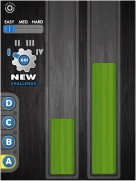The Mathematics Imagery Trainer (MIT) is an interactive technological system designed to create opportunities for students to develop new sensorimotor schemes from which emerge mathematical concepts. In particular, the MIT for proportion (MIT-P) is geared to support the construction of proportional equivalence. We have done extensive research on this design and using variety of media. Here we feature the evolution of the MIT-P. We begin with the very first prototype, a mechanical pulley system operating at a 2:3 ratio (below), then continue to its Wii-mote version, iOS builds, giant touchscreen, and accessible version. (See also Kinemathics page).
The very first build of the Mathematics Imagery Trainer — the mechanical version.
An overview of the design problem and demonstrates the design solution.
Demo from Cyberlearning 2011 that features the Wii-mote version of the MIT-P.
Edutopia film that steps back to present the broader rationale of our project.
A similar remote-control version was experimented successfully, under the supervision of Taylor Martin, at UT Austin by Carmen Petrick Smith, now at the University of Vermont. In her dissertation, she was able to demonstrate that students using the MIT-P outperformed a control group on conceptual items. The principle of dynamical conservation used in our design has been deployed in The Dynamic Number Project (KCP Technologies).
Our iOS build is a free-download iPad/iPhone app called the Mathematics Imagery Trainer. It has been piloted in high schools.



Screenshots from the iPad Mathematics Imagery Trainer for Proportion (built by Terasoft)
PhET (Colorado University), in collaboration with EDRL, has launched an accessible version of the Mathematics Imagery Trainer for proportion.
EDRL has enjoyed a highly productive collaboration with researchers from Utrecht University Arthur Bakker and Marieke van der Schaaf. Together with Shakila Shayan and several MA students, they are doing research on a replication of the iPad MIT-P, yet adding eye-tracking technology for multimodal data gathering. Also, the Utrecht design implements the EDRL rationale to extend from parallel to orthogonal bimanual action.

The MIT-P was instrumental to the doctoral thesis of Carmen Petrick Smith, who implemented it with over 100 students. A version of the MIT-P has been built as a touchscreen tablet by Jochen “Jeff” Rick.
